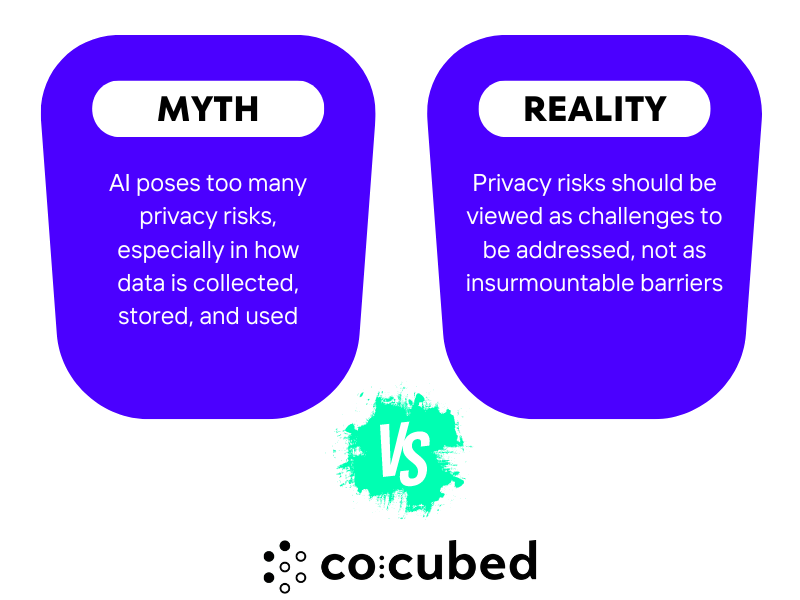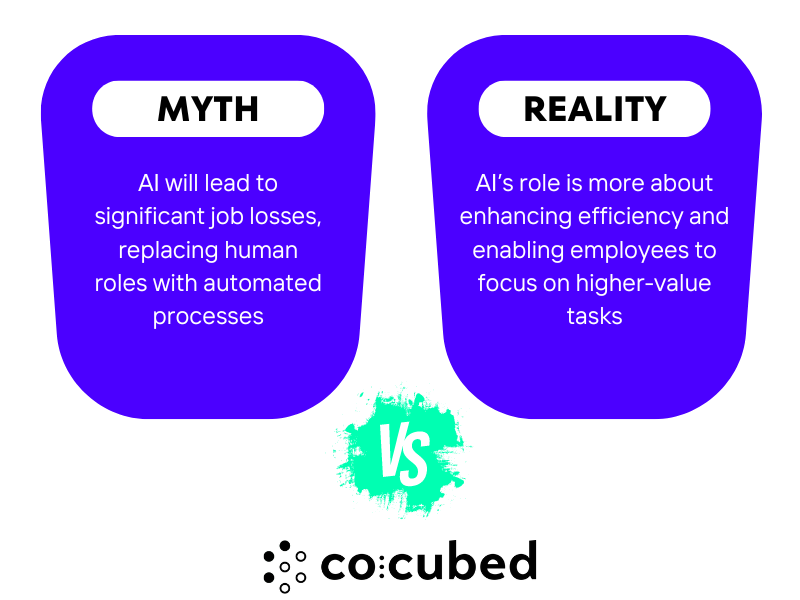AI is shaking up the way large corporates approach open innovation, their startup scouting, and collaboration. However, several persistent myths continue to hold back its full potential. These misconceptions can limit ambition and slow the adoption of AI-driven solutions, particularly in the context of AI collaboration and open innovation. Here’s a closer look at five common myths and how to move beyond them to drive greater impact.
Myth 1: AI is primarily a technology issue
The myth: Many believe AI belongs solely to IT departments or tech teams, with little need for input from other parts of the organisation. This myth assumes that AI projects should be led by technical experts, isolating them from broader business strategies.
The reality: AI isn’t just a technology initiative; it’s a critical component of open innovation that requires cross-functional collaboration. Successful AI integration hinges on aligning AI projects with broader business goals, which demands input and buy-in from diverse teams, including marketing, operations, HR, and finance.

Think of AI as the backbone of your open innovation efforts, connecting various departments and driving collaborative success. Don’t let AI projects remain siloed—bring in voices from all areas of your organisation to explore how AI can enhance their goals. By making AI collaboration a shared effort, you can transform it from a tech initiative into a business-wide innovation engine. Encourage unexpected partnerships between departments to leverage AI’s potential across different challenges and opportunities.
Myth 2: AI poses too many privacy risks
The myth: There’s a growing concern that AI adoption will lead to significant privacy issues, especially in how data is collected, stored, and used. The fear is that AI’s data-driven nature could expose the organisation to compliance risks and damage its reputation, particularly in open innovation projects involving external partners.
The reality: While privacy concerns are valid, they can be managed with the right safeguards in place. Organisations that prioritise data governance and compliance can leverage AI while maintaining customer trust and adhering to regulatory requirements. Privacy risks should be viewed as challenges to be addressed, not as insurmountable barriers.

Instead of viewing privacy concerns as roadblocks, consider them opportunities to differentiate your company in the open innovation space. By investing in robust data privacy measures, you can position your brand as a leader in ethical AI collaboration. Be transparent with your partners and customers about how data is handled and use your strong privacy practices as a competitive advantage. In an era where trust is paramount, your commitment to privacy can set you apart in the crowded open innovation landscape.
Myth 3: AI is too expensive for experimental projects
The myth: Another common belief is that AI requires significant investment, making it less suitable for experimental or pilot projects, especially in startup scouting and open innovation contexts. The concern is that the cost and risk associated with AI might outweigh the potential benefits in early-stage projects.
The reality: AI technologies have become increasingly accessible and scalable, with many options available for pilot projects that don’t require massive upfront investment. AI-as-a-Service (AIaaS) platforms allow organisations to experiment with AI at a lower cost, scaling up only as the benefits become clear.

Rethink your approach to AI partnerships in open innovation—consider them as agile experiments rather than hefty, all-in commitments. Start with small, high-impact pilots in areas like startup scouting, where AI can help identify promising opportunities quickly. Use early wins to build momentum and gather support for larger AI initiatives. By treating AI as a series of iterative experiments, you can foster innovation without overextending your budget. The key is to stay flexible, learn from your experiments, and be ready to scale successful initiatives when the time is right.
Myth 4: AI is too complex to integrate into existing processes
The myth: There’s a misconception that AI is too complex to be integrated into existing business processes, particularly in the context of open innovation and collaborations with startups. This myth suggests that the complexity of AI could disrupt current operations and create more challenges than benefits.
The reality: AI can be complex, but it doesn’t have to disrupt existing processes. Many AI tools are designed to integrate smoothly with current systems, offering enhancements without requiring a complete overhaul. Furthermore, AI can simplify processes by automating routine tasks and providing actionable insights.

Instead of viewing AI as a disruptive force, see it as a secret weapon for streamlining and enhancing your open innovation processes. Start by identifying low-hanging fruit—those tedious, time-consuming tasks in your startup scouting or collaboration efforts that drain resources. Apply AI to make these processes smarter and more efficient, creating quick wins that demonstrate AI’s value. Focus on integrating AI in ways that add value without turning your existing processes upside down. Let AI work in the background, making everything smoother and smarter.
Myth 5: AI replaces jobs, not enhances them
The myth: Many people fear that AI will lead to significant job losses, replacing human roles with automated processes, particularly in innovation teams and roles related to collaboration and startup engagement.
The reality: AI’s role is more about enhancing efficiency and enabling employees to focus on higher-value tasks. In many cases, AI takes over repetitive and data-intensive tasks, allowing human workers to engage in more strategic, creative, or complex problem-solving roles.

Position AI as the ultimate collaborator in your open innovation efforts. Encourage your teams to see AI as a tool that enhances their capabilities, not as a threat to their jobs. Invest in training and development to help employees work alongside AI, empowering them to tackle more creative and strategic challenges. When AI and human intelligence work together, you can unlock new levels of productivity and innovation. Make it clear that AI isn’t here to replace your people—it’s here to help them shine in their roles, especially in high-impact areas like startup scouting and AI collaboration.
Final Thoughts: Overcoming Barriers to AI Adoption in Open Innovation
For large corporations, overcoming these myths is crucial to fully leveraging AI’s potential in open innovation, AI collaboration, and startup scouting. By approaching AI with a strategic, well-rounded perspective, companies can tackle challenges head-on and use AI as a key driver of innovation and growth. At Co:cubed we’re here to help you navigate AI adoption, ensuring that your initiatives align with your broader business strategy and are supported across the organisation. Let’s discuss how AI can elevate your business and drive lasting impact in the rapidly evolving world of open innovation.


